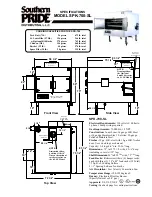
2562042A
REV. A 604
Printed in U.S.A
.
INSTALLATION INSTRUCTIONS FOR
SK145 COMPACT SPEAKER
SAFETY MESSAGE TO INSTALLERS OF SIREN SPEAKERS
WARNING
The lives of people depend on your proper installation
and servicing of Galls products. It is important to read
and follow all instructions shipped with the products.
In addition, listed below are some other important
safety instructions and precautions you should follow:
Before Installation
Qualifications
•
To properly install an electronic siren: you must have a
good understanding of automotive electrical procedures
and systems, along with proficiency in the installation
and service of safety warning equipment. Always refer to
the vehicle's service manuals when performing
equipment installations on a vehicle.
Sound Hazards
•
Your hearing and the hearing of others, in or close to
your emergency vehicle, could be damaged by loud
sounds. This can occur from short exposures to very loud
sounds, or from longer exposures to moderately loud
sounds. For hearing conservation guidance, refer to
federal, state, or local recommendations. OSHA
Standard 1910.95 offers guidance on “Permissible Noise
Exposure.”
•
All effective sirens and horns produce loud sounds (120
dB) that may cause permanent hearing loss. Always
minimize your exposure to siren sound and wear hearing
protection. Do not sound the siren indoors or in enclosed
areas where you and others will be exposed to the sound.
•
Galls siren amplifiers and speakers are designed to work
together as a system. Combining a siren and speaker
from different manufacturers may reduce the warning
effectiveness of the siren system and may damage the
components. You should verify or test your combination
to make sure the system works together properly and
meets federal, state and local standards or guidelines.
During Installation
•
DO NOT get metal shavings inside the product. Metal
shavings in the product can cause the system to fail. If
drilling must be done near the unit, place an ESD
approved cover over the unit to prevent metal shavings
from entering the unit. Inspect the unit after mounting
to be sure there are no shavings present in or near the
unit.
•
DO NOT connect this system to the vehicle battery until
ALL other electrical connections are made, mounting of
all components is complete, and you have verified that
no shorts exist. If wiring is shorted to vehicle frame, high
current conductors can cause hazardous sparks resulting
in electrical fires or flying molten metal.
•
Be sure the siren amplifier and speaker(s) in your
installation have compatible wattage ratings.
•
In order for the electronic siren to function properly, the
ground connection must be made to the NEGATIVE
battery terminal.
•
Sound output will be severely reduced if any objects are
in front of the speaker. If maximum sound output is
required for your application, you should ensure that the
front of the speaker is clear of any obstructions.
•
Install the speaker(s) as far forward on the vehicle as
possible, in a location which provides maximum
signaling effectiveness and minimizes the sound
reaching the vehicle’s occupants. Refer to the National
Institute of Justice guide 500-00 for further information.
•
Mounting the speakers behind the grille will reduce the
sound output and warning effectiveness of the siren
system. Before mounting speakers behind the grille,
make sure the vehicle operators are trained and
understand that this type of installation is less effective
for warning others.
•
Sound propagation and warning effectiveness will be
severely reduced if the speaker is not facing forward.
Carefully follow the installation instructions and always
install the speaker with the projector facing forward.
•
DO NOT install the speaker(s ) or route the speaker
wires where they may interfere with the operation of air
bag sensors.
•
Installation of two speakers requires wiring speakers in
phase.
•
Never attempt to install aftermarket equipment, which
connects to the vehicle wiring, without reviewing a
vehicle wiring diagram - available from the vehicle
manufacturer. Insure that your installation will not
affect vehicle operation and safety functions or circuits.
Always check vehicle for proper operation after
installation.
•
DO NOT install equipment or route wiring or cord in the
deployment path of an air bag.
•
Locate the control head so the vehicle, controls, and
microphone can be operated safely.
•
When drilling into a vehicle structure, be sure that both
sides of the surface are clear of anything that could be
damaged.
After Installation
•
After installation, test the siren system and light system
to ensure that it is operating properly.
•
Test all vehicle functions, including horn operation,
vehicle safety functions and vehicle light systems, to
ensure proper operation. Ensure that installation has
not affected vehicle operation or changed any vehicle
safety function or circuit.
•
After testing is complete, provide a copy of these
instructions to the instructional staff and all operating
personnel.
•
File these instructions in a safe place and refer to them
when maintaining and/or reinstalling the product.
Failure to follow all safety precautions and instructions
may result in property damage, serious injury, or death to you
or others.


























